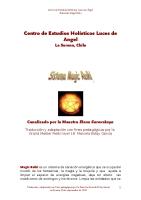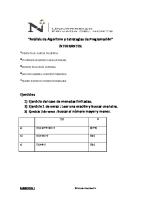lizard-evolution-virtual-lab-student-worksheet 1
Virtual Lab Lizard Evolution Virtual Lab Student Handout LIZARD EVOLUTION VIRTUAL LAB Answer the following qu
Views 86 Downloads 33 File size 247KB
Recommend stories
- Author / Uploaded
- api-314520592
Citation preview
Virtual Lab Lizard Evolution Virtual Lab
Student Handout
LIZARD EVOLUTION VIRTUAL LAB Answer the following questions as you finish each module of the virtual lab or as a final assessment after completing the entire virtual lab. Module 1: Ecomorphs 1. At the beginning of the virtual lab, you were asked to sort eight lizards into categories. What criteria did you initially use to make your groups? Did you revise your criteria later? Why?
I separated the lizards by color, such a brown, brown and spotted, and green. I did not bother with length at the beginning.
2. An adaptation is a structure or function that is common in a population because it enhances the ability to survive and reproduce in a particular environment. Provide one example and an explanation of one adaptation in the Anolis lizards.
One adaptation, such as large toe pads is important because it allows a lizard to climb better. The lizards at the top need these.
3. Provide one evolutionary explanation for why lizards living in the same part of the habitat (i.e., grass) would have similar characteristics.
They need to have similar abilities or else they will not survive there. A lizard lives specific to its traits.
4. What is an ecomorph? Provide one example from the virtual lab.
An eco morph is a species who has the same structural habitat, but are not the same as the original species. An example is the grass-bush anole. 5. How is an ecomorph different from a species? They evolve into different forms to help survive. They evolve to survive their habitat.
6. Explain how a particular body feature of one of the lizard ecomorphs from the virtual lab is an adaptation to their particular niche.
Crown Giant Ecomorphs live at the top of the trees. They are large in size and have long legs to jump from tree to tree, which is important for their habitat.
www.BioInteractive.org
February 2015 Page 1 of 6
Virtual Lab Lizard Evolution Virtual Lab
Student Handout
Module 2: Phylogeny 1. In module 1, you identified which species of lizards were most similar to one another based on relative limb length and toe pad size. In this module, you determined which lizards are more similar to one another based on what type of information?
I decided to group long legs together, short legs together, large toe pads, and body length.
2. Are the species of lizard that are more similar to one another according to body type also more closely related based on the results obtained in this module?
Yes. Even though the species developed in different places, they are more closely related to each other.
www.BioInteractive.org
February 2015 Page 2 of 6
Virtual Lab Lizard Evolution Virtual Lab
Student Handout
3. The figures below show two phylogenetic trees similar to the one you constructed in the virtual lab but with more lizards. The trees below show the evolutionary relationships among species from four ecomorphs from the four largest Caribbean islands. Figure 1. Phylogeny of anole lizards on four of the major Caribbean islands color-‐coded according to geographical distribution. Light dotted line, Puerto Rico; small dashed line, Cuba; large dashed line, Hispaniola; and solid line, Jamaica.
Figure 2. Phylogeny of anole lizards in the four major Caribbean islands colored in according to ecomorph. Light dotted line, twig; small dashed line, trunk-‐ground; large dashed line, trunk-‐ crown; solid line, grass-‐bus.
What conclusion can you draw about the evolution of the Anolis lizards based on these figures?
These lizards developed on different islands, but are so closely related. These animals did not produce and then spread, each island had its own species develop which are very similar. www.BioInteractive.org
February 2015 Page 3 of 6
Virtual Lab Lizard Evolution Virtual Lab
Student Handout
4. What is convergent evolution? Use evidence from the trees to explain how the Anolis lizards are an example of this concept.
It is when an animal indecently evolves and they are si,liar because they have to adapt to such similar habitats and niches.
Module 3: Experimental Data 1. In Dr. Losos’s experiment, why was it important that the experimental islands lacked lizards?
It is important that it lacked lizards so mating with other species would not disturb the experiment.
2. Dr. Losos’s data suggest that after only a few generations, the lizards on the experimental islands have shorter legs on average than the lizards on the larger island. Explain how the data you collected either supports or does not support this claim.
My data does show that the experimental island lizards do have shorter legs. The relative hind leg length was much shorter than the original lizards.
3. Based on what you know about the experimental islands and the lizards that were placed on these islands, explain how and why the average leg length of the population might change over time. Include the concept of natural selection in your discussion.
The leg length average may evolve to longer legs if that is what is needed to survive. 4. If the population from one of the experimental islands was reintroduced on the original island, do you predict that lizards from the two populations would still mate and reproduce? Justify your answer with scientific arguments.
I think they would reproduced because they are so similar, but I think it would create problems in the future.
www.BioInteractive.org
February 2015 Page 4 of 6
Virtual Lab Lizard Evolution Virtual Lab
Student Handout
Module 4: Dewlap Colors 1. Anolis cristatellus and A. cooki are both trunk-‐ground anoles that live on Puerto Rico. A. cristatellus lives in a shady, forest environment, while A. cooki lives in an open, sunny environment. What is an adaptive explanation for why the dewlap of one species evolved to be brighter and that of another species darker?
The brighter the dewalp, normally the darker the environment is. So since cristatellus lizards like a shady environment, their dewalp is much brighter.
2. From the bar graph generated in the virtual lab (see below), how do the dewlap colors of the two species compare?
The cristatellus's dewalp is much brighter.
3. How would you determine whether the difference between the two populations is statistically significant?
Compare charts!
4. If a species of anoles with dark dewlaps colonized a heavily forested island, predict what would happen over time to the color of the dewlap. Using your knowledge of natural selection and genetics, explain your prediction.
I think with reproduction, the dewalp would eventually become brighter, but not much will change besides that. www.BioInteractive.org
February 2015 Page 5 of 6
Virtual Lab Lizard Evolution Virtual Lab
Student Handout
Extension Questions 1. To minimize interspecific competition, organisms often divide the limited available resources in an area, a concept called “resource partitioning.” As an example of this concept, the figure below illustrates how different species of warblers utilize different portions of an individual tree. Figure 3. Different species of North American warblers live in different parts of the same trees. The shaded areas indicate the habitats each warbler species occupies.
2. Explain how the different species of anoles on an island demonstrate “resource partitioning” similar to the warblers in the figure.
The species of the lizards occupy many different parts of the tree like the grass, the trunk, the twigs, and the canopy, much like that Warblers.
3. Explain how resource partitioning can promote long-‐term coexistence of competing species, thus increasing biodiversity.
This can help the environment because there will not be as much competition for a species, making it easier to survive,. www.BioInteractive.org
February 2015 Page 6 of 6









